Analysis of an Immune Crystal Garden
10/2022
-
Abs. -
Floral crystal patterns arise in ruthenium immune complexes designed to transfer charge into the nucleosomes of tumor cells. The images guide our search for agents of therapeutic gene compression.
Intro. -
From prior studies we considered that the free energy of the genetic apparatus could limit DNA replication by microscopic compression of the chromatin (1). This 85 millivolt reduction of DNA by a palladium catalyst was an introductory charge transfer model for gene studies. In follow-up we looked for stronger therapeutic compounds. We wanted to increase the electron free energy of the major molecular components of chromatin - the DNA and the histones. So we synthesized new organo-metallic reducing catalysts, and assayed them for cytotoxicity.
After thirteen years of research and development on this project, we submitted a candidate Ruthenium immune complex (Toroglobulin), to the National Cancer Institute. They performed in vitro cell line screening and reported strong activity against all the leukemia lines (NCI60- Fig.1). However, the effects against cell lines of solid tumors were weaker than in the leukemia lines. This recalls a phenomenon called “the solid tumor barrier” (2), which refers to the greater difficulty in treating solid tumors (rather than leukemias) with drugs. Because of this problem we extended research towards improving the range and activity of the compound. The mechanism of Toroglobulin is correlated with its behavior as a histone reductase, in which it transfers 416 millivolts of energy to histone ( ref.3, and Fig.4 ). This mechanism has been acknowledged at the National Cancer Institute (4). Histone is part of the nucleosome genetic apparatus and is closely involved in chromatin compression, and therefore in gene regulation.
To overcome the solid tumor barrier we added a patented synthetic magnetic molecular component - Rux (5) to Toroglobulin (3). The resulting waveform was visualized on a Hantek oscilloscope with a magnetic electrode (Magnetic Sciences and Beehive Electronics). This new complex produces a periodic oscillation apparent on the oscilloscope (Fig.5). Stabilization of the oscillation signal was achieved by addition of hyaluronic acid. This stable complex we call IgG-Bouquet (a), and it is the first of the floral immune crystals (Fig.2).
Methods -
To make IgG Bouquet, three feedstock solutions are prepared. They are Toroglobulin, Rux, and Hyaluronic acid. The Rux patent (5) and the Toroglobulin patent (3) contains details of their respective syntheses. Hyaluronic acid is obtained from Sigma and is prepared as a 2.0 % aqueous solution. Initially these three components are prepared as 2.0 % aqueous solutions. Equal volumes of these components are stirred together gently for five minutes. The product is IgG Bouquet. A sterile 10 uLloop is used to spread this material on a glass microscope slide. The material is allowed to dry and observed over several days with Phase microscopy at low power. The floral patterns begin to appear in 10 minutes (Fig.2), and then become larger and more numerous through time.
It became clear that we could produce hundreds of these beautiful Bouquet forms, hence the idea of an immune crystal garden. This crystal garden imitates biologic form without cellular material. The immune identity here is due to the matrix of human gamma globulin incorporated in the original synthesis (3). We hope this graphic model will be useful in other investigations into the solid tumor barrier.
Some investigators will seek clarity on the crystal oscillator kinetics. We think the electron transfer by Toroglobulin combined with the inductive field in Rux may form an oscillator tank circuit. Further studies will examine this idea. The oscillation kinetics are further enriched by the ability of Toroglobulin to form fractal sine waves with amino acids (6).
I report on the production of vine-like floral patterns using two molecular complexes without cellular material or nucleic acids (Fig.2). The cooperative properties of these molecular complexes appears to be their equivalent circuit contributions towards an oscillator tank circuit. A tank circuit requires a capacitance and an inductance as alternating energy reservoirs. In this study, the capacitance source was expressed by Toroglobulin, a candidate anti-tumor compound (2). Toroglobulin is an organo-metallic complex with a 416 millivolt reducing potential with respect to histone. The inductance source was expressed by Rux, an organo-metallic drug candidate for the treatment of inflammation (3).
We search to understand the properties allowing this combination of chemical agents to simulate floral forms. A review of liquid crystals by Virga (7) reveals one candidate precursor structure is a rudimentary vortex (Virga p.157) which is a liquid crystal spiral pinwheel. This flat pinwheel lacks only a third dimension to achieve conical and floral configurations. A more ideal floral precursor would be a conical vortex.
When we mix Toroglobulin and Rux we generate floral images as seen under phase microscopy (LP) (Fig.2). The mixture of the two complexes assembles the hypothetical charge oscillator. The floral forms produced have greater stability if hyaluronic acid is added to this mixture. We consider hyaluronic acid to be stabilizing because its dielectric properties facilitate charge transfer.
Interpreting the meaning of these floral configurations is exploratory. One idea is to treat the phenomenon as a flux dependent polarization. This premise argues that flux dependent polarization is a mechanistic reaction in biology.
FIGURES
Fig.1 - The NCI60 in vitro screen on Toroglobulin - The first group of six specimens assayed below are the Leukemia lines.
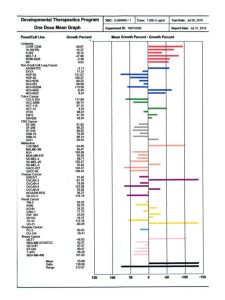 Fig.2 - IgG Bouquet (a)(Phase LP). This is a purely molecular simulation of biologic form. -
Fig.2 - IgG Bouquet (a)(Phase LP). This is a purely molecular simulation of biologic form. -
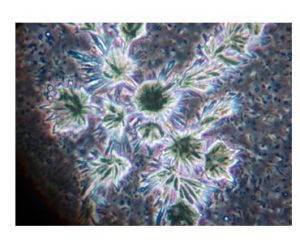 Fig.3 - Periodic Oscillation by Toroglobulin on a Hantek Oscilloscope with a magnetic electrode. Three oscillation bursts are shown.
Fig.3 - Periodic Oscillation by Toroglobulin on a Hantek Oscilloscope with a magnetic electrode. Three oscillation bursts are shown.
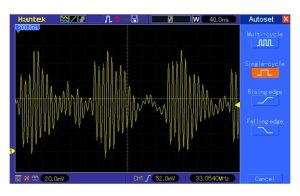 Fig. 4 – Toroglobulin charge transport on a potentiostat with a gold electrode. This is a large energy shift.
Fig. 4 – Toroglobulin charge transport on a potentiostat with a gold electrode. This is a large energy shift.
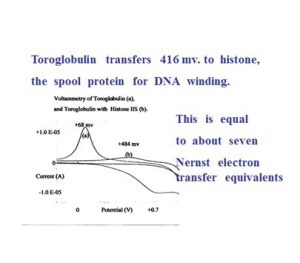 Fig. 5- IgG Bouquet Oscillator -
Complex waveform on a Hantek Oscilloscope with a magnetic electrode. The waveform has changed.
Fig. 5- IgG Bouquet Oscillator -
Complex waveform on a Hantek Oscilloscope with a magnetic electrode. The waveform has changed.
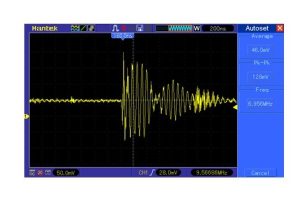 References -
1. M.Garnett, US Patent No. 5,463,093, Oct.31,1995, Palladium Complexes and Methods for Using Same in the Treatment of Tumors and Psoriasis.
2. The Solid Tumor Barrier, PROTO, Mass.General Hosp., June 17, 2019
3. M.Garnett, US Patent No. 10,472,379 B2, Nov.12, 2019, Ruthenium Sphingomyelin Complexes And Methods For Their Use In The Treatment Of Tumors.
4. Letter from NCI screening committee - Dr. James H. Doroshow , June 4,2020. Follow up phone call.
5. M.Garnett, US. Patent No. 9,605,012 B2, Mar.28, 2017, Palladium-Rutenium-Zinc-Organo Complexes And Methods For Their Use In The treatment Of Inflammatory Diseases.
6. Garnett M., Valane P., Fractal Sine Wave of a Histone Reductase Drug Candidate, Electrochemical Society Meeting Abstracts, V. MA2021-02,Issue 48, pp.1905, Oct.2021.
7. Virga, E.G., Variational Theories of Liquid Crystals, Chapman and Hall, NY 1994.
References -
1. M.Garnett, US Patent No. 5,463,093, Oct.31,1995, Palladium Complexes and Methods for Using Same in the Treatment of Tumors and Psoriasis.
2. The Solid Tumor Barrier, PROTO, Mass.General Hosp., June 17, 2019
3. M.Garnett, US Patent No. 10,472,379 B2, Nov.12, 2019, Ruthenium Sphingomyelin Complexes And Methods For Their Use In The Treatment Of Tumors.
4. Letter from NCI screening committee - Dr. James H. Doroshow , June 4,2020. Follow up phone call.
5. M.Garnett, US. Patent No. 9,605,012 B2, Mar.28, 2017, Palladium-Rutenium-Zinc-Organo Complexes And Methods For Their Use In The treatment Of Inflammatory Diseases.
6. Garnett M., Valane P., Fractal Sine Wave of a Histone Reductase Drug Candidate, Electrochemical Society Meeting Abstracts, V. MA2021-02,Issue 48, pp.1905, Oct.2021.
7. Virga, E.G., Variational Theories of Liquid Crystals, Chapman and Hall, NY 1994.
« View All
